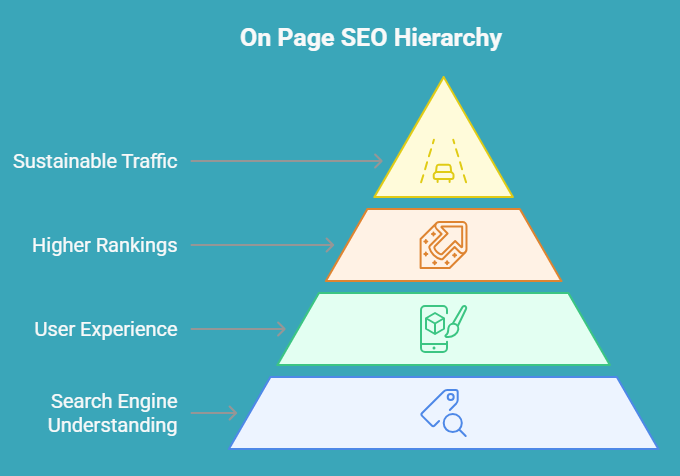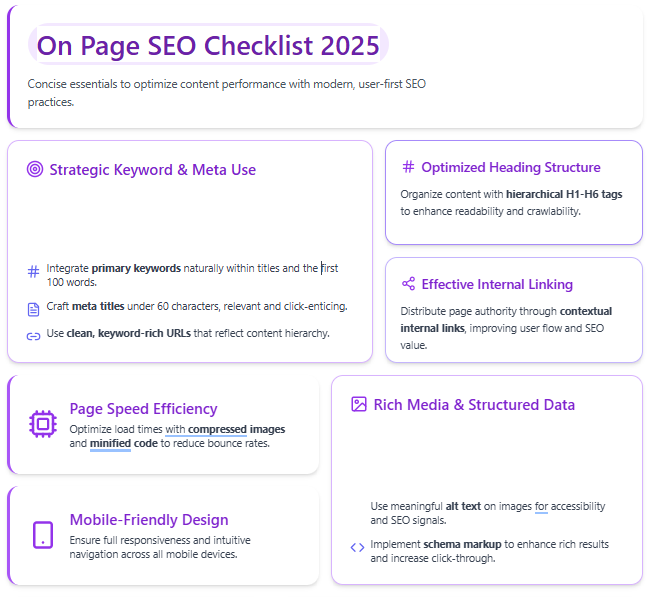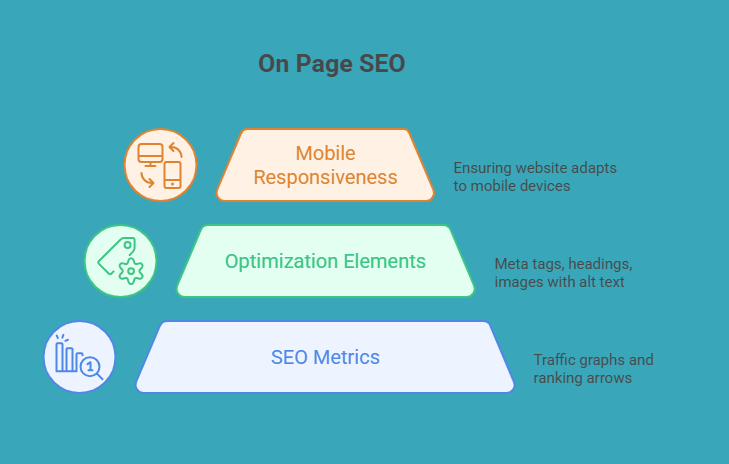What is On Page SEO? (Featured Snippet
On Page SEO refers to the practice of optimizing individual web pages on your website to improve search engine rankings and attract relevant traffic. Unlike off-page SEO, which relies on backlinks and external signals, On Page SEO focuses on content, HTML elements, user experience, and site structure.
Optimizing your pages properly ensures search engines understand your content and your audience finds it engaging. Even the most authoritative backlinks cannot compensate for poorly optimized pages.
Why On Page SEO is Crucial in 2025
With search engines becoming smarter, ranking depends on more than just content. Google and other search engines now evaluate user experience, site structure, and content quality when ranking pages.
Key reasons On Page SEO is essential:

- Enhanced Search Engine Understanding: Optimized meta tags, headings, and structured content facilitate easier indexing by search engines.
- Enhanced User Experience: Well-formatted pages, fast loading, and mobile-friendly design keep visitors engaged longer.
- Higher Rankings: On Page factors directly influence SERP positions.
- Sustainable Traffic: Proper On Page SEO builds a long-term foundation for organic visibility.
Core Elements of On Page SEO
1. Content Optimization
Content is the backbone of On Page SEO. Quality content should:
- Include primary and secondary keywords naturally
- Be structured for readability with short paragraphs, headings, and lists
- Answer user intent directly
- Provide clear and actionable insights
Well-optimized content increases dwell time, reduces bounce rate, and signals value to search engines.
2. Title Tags & Meta Descriptions
Optimizing title tags and meta descriptions is crucial for click-through rates and rankings
- Title Tags: Include your primary keyword and keep them under 60 characters.
- Meta Descriptions: Should summarize the page content in 155–160 characters, including your keyword.
3. Headings (H1, H2, H3)
Headings structure your content for users and search engines:
- H1: One per page with the primary keyword
- H2: Main sections (secondary keywords can be included)
- H3: Sub-points, lists, or examples
Proper heading structure makes content scannable and improves SEO performance.
4. URL Optimization
Optimized URLs are short, descriptive, and keyword-rich.
5. Internal Linking
Internal links help search engines understand content hierarchy and improve crawlability.
- Link to related pages using descriptive anchor text
- Avoid orphan pages (pages without internal links)
- Spread link equity across high-priority pages
Example: “Learn more about On Page SEO Services to boost your rankings.”
6. Image Optimization
Optimized images improve page speed and SEO:
- Use descriptive filenames (
on-page-seo-checklist.jpg) - Add alt text with relevant keywords
- Compress images for faster loading
- Implement lazy loading to enhance user experience
7. Mobile Optimization
Mobile-first indexing means your mobile site determines rankings.
Checklist for mobile optimization:
- Responsive design
- Touch-friendly navigation
- Fast loading on mobile networks
- Consistent content across devices
8. Page Speed
Fast-loading pages improve rankings and user satisfaction.
Speed optimization techniques:
- Minify CSS, JavaScript, and HTML
- Compress images and video files
- Use caching & Content Delivery Networks (CDNs)
- Optimize server response times
On Page SEO Services
Professional On Page SEO Services help businesses optimize pages effectively.
Typical services include:
- Keyword research & mapping
- Content and meta tag optimization
- Heading and URL structure optimization
- Internal linking strategy
- Image SEO & media optimization
- Page speed & mobile responsiveness improvement
- Schema/structured data implementation
Benefits of hiring experts:
- Save time and avoid common mistakes
- Access premium SEO tools
- Regular audits and actionable reports
- Better ROI from organic traffic
On Page SEO vs Off Page SEO
/* Table styling */ .seo-table { width: 100%; border-collapse: collapse; font-family: Arial, sans-serif; margin: 20px 0; transition: transform 0.3s ease; }.seo-table th, .seo-table td { border: 1px solid #ddd; padding: 12px 15px; text-align: left; transition: background-color 0.3s ease, transform 0.3s ease; }.seo-table th { background-color: #3AA6B9; color: #ffffff; }.seo-table tr:nth-child(even) { background-color: #f9f9f9; }.seo-table tr:hover td { background-color: #e0f7fa; transform: scale(1.02); }.seo-table td { vertical-align: top; }| Aspect | On Page SEO | Off Page SEO |
|---|---|---|
| Focus | Focuses on optimizing page content and HTML elements to improve search rankings and user experience. | Focuses on building backlinks and external signals to increase website authority and trust. |
| Key Elements | Includes meta tags, headings, URLs, images, and internal linking for better optimization. | Involves link building, social shares, and other external strategies to boost domain authority. |
| Tools Needed | Tools like Yoast, SEMrush, and Screaming Frog help analyze and optimize on-page elements. | Tools like Ahrefs, Majestic, and BuzzSumo help identify backlinks and monitor off-page performance. |
| Skill Level | Suitable for beginners to intermediate SEO practitioners. | Requires intermediate to advanced SEO knowledge. |
| Impact Timeline | Results are usually visible in 2–6 weeks, depending on competition and content quality. | Results may take 3–6 months as link authority and domain reputation build over time. |
Common On Page SEO Mistakes
Keyword Stuffing
Keyword stuffing occurs when a page overuses the target keyword unnaturally. Search engines may penalize pages that try to manipulate rankings this way.
Example: Repeating “On Page SEO” 20 times in a 300-word article looks unnatural.
Solution: Use your primary and secondary keywords naturally, include related terms (LSI keywords), and focus on writing for users rather than search engines.
Duplicate Meta Descriptions
Having the same meta description on multiple pages confuses search engines about which page to rank. It can also reduce your click-through rate in search results.
Solution: Write unique, compelling meta descriptions for each page that summarize the content and include your primary keyword naturally.
Poor Heading Structure
Skipping proper heading hierarchy (H1 → H2 → H3) or using multiple H1s per page makes it difficult for search engines to understand your content structure.
Solution: Use one H1 per page with your primary keyword, H2s for main sections, and H3s for subsections or examples. This improves both readability and SEO.

Slow-Loading Pages
Pages that take too long to load frustrate users and negatively affect rankings. Google considers page speed a ranking factor, especially for mobile-first indexing.
Solution: Optimize images, minify CSS/JS/HTML, use browser caching, and implement a Content Delivery Network (CDN) to reduce load times.
Non-Mobile-Friendly Design
With mobile-first indexing, if your website is not mobile-friendly, it can significantly hurt your rankings and user experience.
Solution: Use responsive design, ensure buttons and links are easy to tap, and test pages on multiple devices to maintain a consistent mobile experience.
Missing Alt Text
Images without alt text miss out on SEO opportunities and can negatively affect accessibility for visually impaired users.
Solution: Add descriptive alt text for every image, including relevant keywords naturally, to improve search engine understanding and accessibility.
On Page SEO Checklist
Primary keyword in title, H1, and introduction
- Ensures search engines immediately understand the topic of your page.
- Helps improve rankings for the target keyword while signaling relevance to users.
Meta title <60 characters, meta description <160 characters
- Prevents truncation in search results.
- Makes your snippet attractive and clickable, increasing click-through rate (CTR).
Short, descriptive URL with keyword
- Clean URLs are easier for users to read and remember.
- Search engines prefer URLs that reflect the page content.
- Example:
fastdigital360.com/on-page-seo-guide
Optimized headings (H1, H2, H3)
- One H1 per page with the primary keyword; H2s for main sections; H3s for subpoints.
- Helps both users and search engines understand content hierarchy.
Internal linking to relevant pages

- Connects related content across your website.
- Improves crawlability and distributes link equity to important pages.
- Example anchor text: “Learn more about On Page SEO Services.”
Fast page speed (<3 seconds)
- Reduces bounce rate and improves user experience.
- Search engines factor page speed into rankings.
- Use image compression, caching, and minified code to optimize speed.
Mobile-friendly layout
- Ensures usability on all devices.
- Critical for Google’s mobile-first indexing and user engagement.
Optimized images with alt text
- Alt text helps search engines understand image content and can improve image search visibility.
- Descriptive filenames and compressed images also enhance page load times.
Schema markup (FAQ, Article)
- Structured data helps search engines generate rich snippets in search results.
- Can boost CTR and enhance search visibility.
Avoid keyword stuffing
- Overusing keywords can lead to penalties.
- Focus on natural keyword placement and semantic variations to improve readability and rankings.
FAQs
Q1: What is the difference between On Page and Off Page SEO?
On Page SEO focuses on internal optimization; Off Page SEO focuses on backlinks and external authority.
Q2: How long does On Page SEO take to show results?
Usually 4–8 weeks depending on competition and site authority.
Q3: Do I need On Page SEO services if I have backlinks?
Yes. Backlinks alone won’t maximize your page’s potential without proper optimization.
Q5: How often should On Page SEO be updated?
Every 6 months or after major algorithm changes.
Conclusion
On Page SEO is the foundation of website success.
Even the best backlinks or content won’t perform without proper page optimization. By following this On Page SEO Guide and considering professional On Page SEO Services, you ensure:
- Higher rankings in search results
- Increased organic traffic
- Improved user experience
- Long-term sustainable growth
Start today: optimize your meta tags, headings, content, URLs, images, and internal linking, and watch your website rankings improve.
For expert On Page SEO services, contact FastDigital360 to maximize your website’s organic performance.




